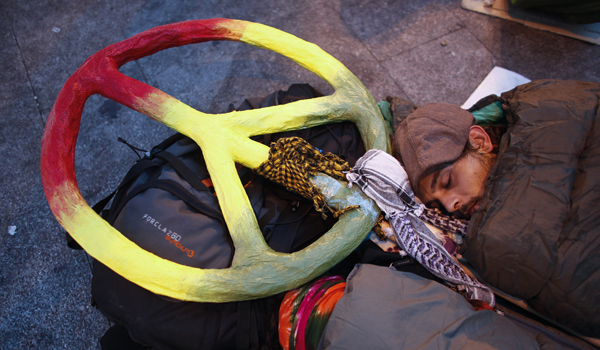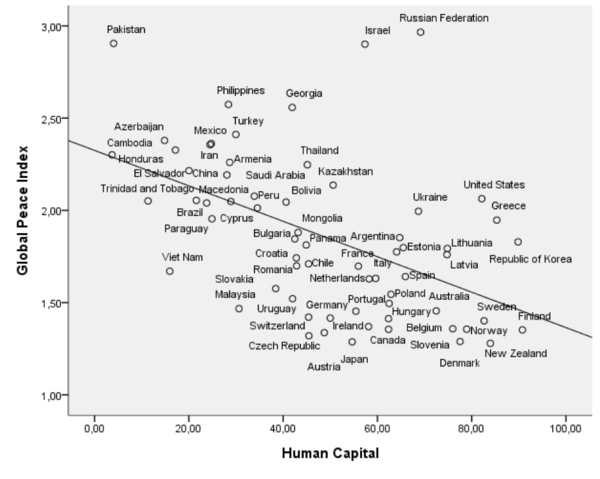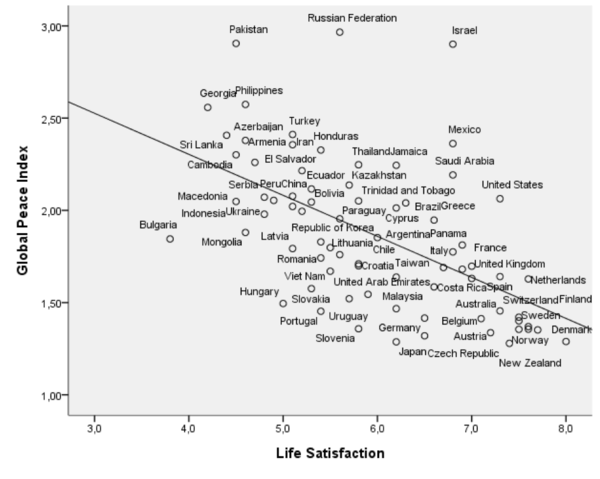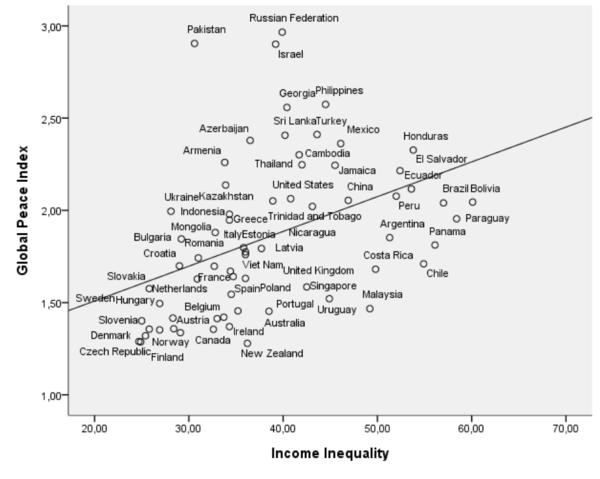The Geography of Peace
What are the factors that shape the relative peacefulness of nations?

The overall level of world peace world fell for the third year in a row, according to the latest version of the Global Peace Index produced by the Institute for Economics and Peace. Most of this trend was driven by the increased "social and political turmoil in the Middle East and North African Nations during the early part of 2011," the report notes.
But what are the factors that shape the relative peacefulness of nations? And, what is the connection between peace—or its opposite—on their economic growth, well-being, and prosperity?
The map below charts the Global Peace Index (GPI) scores for 153 countries worldwide. The GPI is based on 25 separate indicators of internal and external conflict, including wars and external conflicts, deaths from external conflicts, militarization, weapons exports, homicides, access to weapons, violent political demonstrations, prison populations, and police presence.

Iceland and New Zealand are the first and second most peaceful countries on the planet according to the GPI, followed by Japan, Denmark, and the Czech Republic. Canada is ranked eighth. Not surprisingly, the US—with the world's largest military, enmeshed in a seemingly "perpetual war" on terrorism, a large prison population, high homicide rate, and relatively large domestic police presence—is ranked 82nd, between Gabon (81) and Bangladesh (83). The five least peaceful nations are North Korea, Afghanistan, Sudan, Iraq, and Somalia. War-ravaged Libya fell from 83 to 143. It's worth pointing out the considerable differences among the rising BRICs nations. Two of them have high GPI scores—Russia (147) and India (135) - and thus rank among the world's least peaceful nations, while the other two—Brazil (74) and China (80)—rank in the neighborhood of the United States.
I thought it would be interesting to compare countries' rankings on the GPI to their standings on a number of other economic, social, and demographic factors. With the help of my Martin Prosperity Institute colleague Charlotta Mellander, we ran the numbers and generated a series of scattergraphs, plotting GPI against these other metrics. Our analysis only covers approximately 75-80 countries due to data availability. Also note that the higher the GPI score, the less peaceful a country is. Though we found strong associations between a country's prosperity and its GPI, we can't say for certain whether peace promotes prosperity or prosperity promotes peace—or whether other factors that we haven't considered play an equal or greater role. But the patterns that come up are intriguing enough to report here.

Generally speaking, peace follows the level of economic development. A large number of affluent, advanced nations - Norway, Canada, Denmark, Japan and New Zealand—are among the most peaceful in the world. The GPI is strongly associated with the level of economic development (a correlation of -.6—recall that the higher the GPI is, the less peaceful a nation is, hence the negative correlation). There are also quite a few outliers, Russia, Israel and the United States among them. Great powers, economically dominant countries like the US today or the UK in the past, have also always developed large militaries. So have their rivals, like the USSR during the Cold War, or France and Germany on the continent during the days when England reigned supreme.

Peace is also a product of the type of development, not just its level. The apex of economic development has shifted from resource extraction and manufacturing economies, with their large working classes, to more highly-educated and idea-driven post-industrial knowledge economies.
The GPI is closely associated with the share of workers in professional, technical and creative fields (-.48) and also with human capital (-.45, see also the scatter-graph above). Russia, Israel and Pakistan are extreme outliers.

It almost goes without saying that peaceful countries have higher levels of happiness and well-being. When people don't have to worry about sending their children off to war, being invaded by enemy armies, or terrorists with suicide bombs, they naturally experience higher levels of life satisfaction. So it's not surprising that the two are closely associated statistically, with a correlation of -.52 (once again, remember that a higher GPI score reflects a lower level of peace, hence the negative correlation). The US is again something of an outlier here, situated near Mexico and Saudi Arabia—nations with significantly higher levels of well-being than their GPI scores might predict. Israel, Russia and Pakistan remain the extreme outliers.

And finally for the biggest takeaway: There is a considerable positive correlation (.42) between the GPI and income inequality (see above). Nations with less income inequality have higher levels of peace, while inequality is associated with peace's opposite. Once more, Russia, Israel and Pakistan are the outliers. Central American and South American nations do particularly poorly on this measure—look at Honduras, El Salvador, and Ecuador, far out on the upper right quadrant. This tendency might be even more pronounced had we had the data for some African countries. Countries with strong inequality are often poorer nations with resource-based economies. Such nations are more likely to be governed by the kinds of authoritarian regimes that are prone to strong man tactics internally and maintain tense relations with neighboring states.
Whether prosperity breeds pacific attitudes or vice versa is open to debate, but it's abundantly clear that peace goes along with relative affluence, higher living standards and greater levels of happiness, while its absence means the reverse. It makes good sense to see peace-making and economic development as mutually-reinforcing goals and strategies. War and violence are troubling by humane standards. They also run counter to the wealth and happiness of nations.
Image: Paul Hanna/Reuters